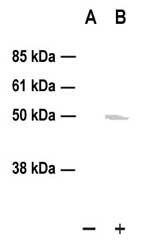PC386
PhosphoDetect Anti-p53 (pSer¹⁵) (Ab-3) Rabbit pAb
liquid, Calbiochem®
Sign Into View Organizational & Contract Pricing
All Photos(1)
About This Item
UNSPSC Code:
12352203
NACRES:
NA.41
clone:
polyclonal
application:
species reactivity:
rat, mouse, human
citations:
11
biological source
rabbit
Quality Level
antibody form
affinity isolated antibody
antibody product type
primary antibodies
clone
polyclonal
form
liquid
does not contain
preservative
species reactivity
rat, mouse, human
manufacturer/tradename
Calbiochem®
storage condition
OK to freeze
isotype
IgG
shipped in
wet ice
storage temp.
−20°C
target post-translational modification
phosphorylation (pSer15)
Gene Information
human ... TP53(7157)
General description
Immunoaffinity purified rabbit polyclonal antibody. Recognizes the ~53 kDa p53 protein phosphorylated on Ser15.
Recognizes the ~53 kDa p53 protein phosphorylated at Ser15 in PC12 or HeLa cells treated with DNA damaging agents. Does not recognize unphosphorylated p53.
This PhosphoDetect Anti-p53 (pSer¹⁵) (Ab-3) Rabbit pAb is validated for use in Immunoblotting , Immunoprecipitation for the detection of p53 (pSer¹⁵) (Ab-3).
Immunogen
Human
a synthetic phosphopeptide corresponding to amino acids surrounding the Ser¹⁵ phosphorylation site of human p53, conjugated to KLH
Application

Immunoblotting (1:1000)
Immunoprecipitation (1:200)
Warning
Toxicity: Standard Handling (A)
Physical form
In 150 mM NaCl, 10 mM sodium HEPES, 100 µg/ml BSA, 50% glycerol, pH 7.5.
Reconstitution
Following initial thaw, aliquot and freeze (-20°C). Avoid freeze/thaw cycles.
Analysis Note
Positive Control
PC-12, HCT116, or HeLa cells treated with DNA damaging agents
PC-12, HCT116, or HeLa cells treated with DNA damaging agents
Other Notes
Does not recognize non-phosphorylated p53. Antibody should be titrated for optimal results in individual systems.
Tibbetts, R.S., et al. 1999. Genes Dev.13, 152.
Levine, A.J. 1997. Cell88, 323.
Milczarek, G.J., et al. 1997. Life Sci.60, 1.
Shieh, S.Y., et al. 1997. Cell91, 325.
Meek, D.W. 1994. Semin Cancer Biol.5, 203.
Levine, A.J. 1997. Cell88, 323.
Milczarek, G.J., et al. 1997. Life Sci.60, 1.
Shieh, S.Y., et al. 1997. Cell91, 325.
Meek, D.W. 1994. Semin Cancer Biol.5, 203.
Legal Information
CALBIOCHEM is a registered trademark of Merck KGaA, Darmstadt, Germany
Not finding the right product?
Try our Product Selector Tool.
Storage Class Code
10 - Combustible liquids
WGK
WGK 2
Certificates of Analysis (COA)
Search for Certificates of Analysis (COA) by entering the products Lot/Batch Number. Lot and Batch Numbers can be found on a product’s label following the words ‘Lot’ or ‘Batch’.
Already Own This Product?
Find documentation for the products that you have recently purchased in the Document Library.
Timothy R Schwartz et al.
BMC molecular biology, 8, 7-7 (2007-01-30)
The repair of single base mutations in mammalian genes can be directed by single-stranded oligonucleotides in a process known as targeted gene repair. The mechanism of this reaction is currently being elucidated but likely involves a pairing step in which
Rene Rodriguez et al.
Neoplasia (New York, N.Y.), 11(4), 397-407 (2009-03-25)
There is growing evidence about the role of mesenchymal stem cells (MSCs) as cancer stem cells in many sarcomas. Nevertheless, little is still known about the cellular and molecular mechanisms underlying MSCs transformation. We aimed at investigating the role of
Jasmine R Elison et al.
Archives of ophthalmology (Chicago, Ill. : 1960), 124(9), 1269-1275 (2006-09-13)
To determine the efficacy of inducing p53-mediated cell death in retinoblastoma cells by Nutlin 3A, a small molecule HDM2 inhibitor. Retinoblastoma cell lines WERI-RB-1 and Y79 were treated with Nutlin 3A. Cell viability assays, Western blot analyses, confocal microscopy, and
Awad Shamma et al.
Molecular and cellular biology, 33(16), 3113-3124 (2013-06-12)
The retinoblastoma tumor suppressor gene (RB) product has been implicated in epigenetic control of gene expression owing to its ability to physically bind to many chromatin modifiers. However, the biological and clinical significance of this activity was not well elucidated.
Stefano J Mandriota et al.
The Journal of biological chemistry, 285(17), 13092-13106 (2010-02-24)
Carriers of mutations in the cell cycle checkpoint protein kinase ataxia telangiectasia mutated (ATM), which represent 1-2% of the general population, have an increased risk of breast cancer. However, experimental evidence that ATM deficiency contributes to human breast carcinogenesis is
Our team of scientists has experience in all areas of research including Life Science, Material Science, Chemical Synthesis, Chromatography, Analytical and many others.
Contact Technical Service